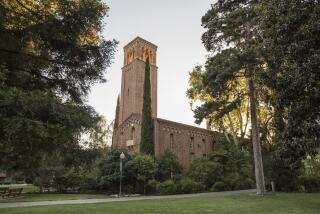Real-World Lessons During Spring Break
- Share via
WASHINGTON — A year ago, Melissa Drouin lay on Cancun’s white sand beach, the crystalline Caribbean lapping at her toes, an unlimited supply of tropical drinks at her fingertips.
It was spring break, and with thousands of other U.S. college students, Drouin was at a beautiful Mexican seaside resort with nothing much to do except sleep, swim, drink and dance till dawn.
The University of Maine junior was back on spring break this week, but this time at a nursing home in Washington, D.C. Whether the days were gray, cold and drizzly or sunny, balmy and bright, she and 10 other students from Maine were tied to a schedule, volunteering at the home from 10 a.m. until 5 p.m. for five days.
They slept in a youth hostel downtown, where they shared cooking duties. They all had signed a “chem-free” pledge--violators to be sent home at their own expense. Each had pitched in $75 in addition to raising the money to pay for this break.
They’re part of a nationwide trend called “alternative spring break,” an idea born at Vanderbilt University in 1991 to promote service and heighten social awareness among college students.
The national program, Break Away, now has chapters at 62 colleges. More than 5,000 students are participating at 300 locations this year, officials said.
By the middle of her second day at the Washington Home, Drouin knew it was all worthwhile, she said.
There, in the middle of the lounge in the special care unit--where those afflicted with Alzheimer’s disease and other forms of dementia live--danced the woman that Drouin had spent hours with that morning. In a whisper-soft voice, the woman had fretted about some vague discomfort, which Drouin tried to ease with soothing words and some water in a plastic cup.
The conversation of the thin, stooped woman was disjointed and difficult to follow. But now she was swaying in the arms of her husband, who had come to visit. Drouin and another student were playing “Strangers in the Night” on a boombox, planning to dance with residents as part of music therapy.
But Drouin had to leave the room.
“She had her head on his shoulder, and they were slow-dancing to Frank Sinatra. And you know that ball you get in your chest? I had to leave. I had tears going down my face,” said Drouin, a nursing major. “I’m sure she’s not the same person he’s known all his life, but you could see in his face how important it was to him to be here.”
Before the Maine students arrived, students from the University of Michigan and the University of Florida also spent their spring breaks at the Washington Home.
“It makes such a difference with what we can do for our residents,” said Lauren Feeney, the home’s volunteer coordinator. “People are saying they wish they had [the volunteers] all the time.”
The week clinched Kristy Townsend’s decision to apply for a neuroscience doctoral program.
The 22-year-old senior, who is majoring in biochemistry, now wants to do research on Alzheimer’s. But for many of her peers, who take their mental acuity, good health and physical independence for granted, the week wasn’t easy.
Misty Smith, 22, a senior psychology major, decided that working with the elderly isn’t for her. “I feel drained after five minutes,” she said. “I see them at a point where they need assistance, and it’s hard to see that without wanting to do something about it--and I can’t.”
Jonathan Dunn, 19, also was brought to tears on his second day.
“I was just overcome by the fact that someone this smart is left completely dependent on others,” Dunn said of a resident he talked with. “I don’t want to think how I would be in that situation.”
Five other groups from the university took the alternative spring break, volunteering with terminally ill children in Florida, an AIDS hospice in New Orleans, a home for troubled boys in South Carolina, a children’s literacy program in Atlanta and the Gay Men’s Health Crisis Center in New York City. This was the fifth year the university has participated in the program.
“We feel it’s important that our students do this. Some of the students from Maine haven’t even been exposed to some of these kinds of environments, and besides, we just think that doing service for the community is important,” said Mary Skaggs, director of the university’s student employment and volunteer programs.
“It’s not just all about school.”
More to Read
Sign up for Essential California
The most important California stories and recommendations in your inbox every morning.
You may occasionally receive promotional content from the Los Angeles Times.













